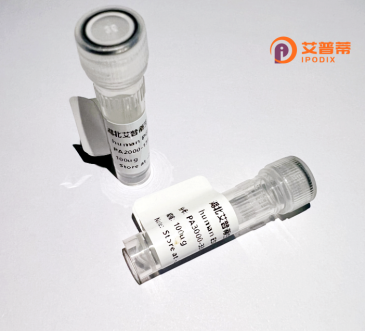
| 纯度 | >90%SDS-PAGE. |
| 种属 | Human |
| 靶点 | WWP1 |
| Uniprot No | Q9H0M0 |
| 内毒素 | < 0.01EU/μg |
| 表达宿主 | E.coli |
| 表达区间 | 1-251 aa |
| 活性数据 | MSAYGMPMYKSGDLVFAKLKGYAHWPARIEHMTQPNRYQVFFFGTHETAFLSPKRLFPYKECKEKFGKPNKRRGFSAGLWEIENNPTVQASDCPLASEKGSGDGPWPEPEAAEGDEDKPTHAGGGGDELGKPDDDKPTEEEKGPLKRSAGDPPEDAPKRPKEAAPDQEEEAEAERAAEAERAAAAAAATAVDEESPFLVAVENGSAPSEPGLVCEPPQPEEEELREEEVADEEASQEWHAEAPGGGDRDSL |
| 分子量 | 53.6 kDa |
| 蛋白标签 | GST-tag at N-terminal |
| 缓冲液 | PBS, pH7.4, containing 0.01% SKL, 1mM DTT, 5% Trehalose and Proclin300. |
| 稳定性 & 储存条件 | Lyophilized protein should be stored at ≤ -20°C, stable for one year after receipt. Reconstituted protein solution can be stored at 2-8°C for 2-7 days. Aliquots of reconstituted samples are stable at ≤ -20°C for 3 months. |
| 复溶 | Always centrifuge tubes before opening.Do not mix by vortex or pipetting. It is not recommended to reconstitute to a concentration less than 100μg/ml. Dissolve the lyophilized protein in distilled water. Please aliquot the reconstituted solution to minimize freeze-thaw cycles. |
以下是关于重组人WWP1蛋白的3-4篇代表性文献概览:
1. **文献名称**:*"WWP1 regulates PTEN ubiquitination and localization to suppress tumorigenesis"*
**作者**:Lee et al.
**摘要**:该研究揭示WWP1作为E3泛素连接酶,通过介导PTEN蛋白的多聚泛素化修饰,改变其细胞核-质分布,抑制PTEN的肿瘤抑制功能,从而促进癌症的发生(如前列腺癌)。
2. **文献名称**:*"Hippo-YAP signaling is targeted by WWP1-mediated ubiquitination in cancer progression"*
**作者**:Chen et al.
**摘要**:研究发现WWP1与Hippo信号通路中的YAP蛋白直接互作,通过K63泛素化修饰增强YAP的稳定性,促进其下游靶基因表达,加速细胞增殖和肿瘤转移。
3. **文献名称**:*"WWP1 controls neuronal differentiation via ubiquitination of SOX9"*
**作者**:Su et al.
**摘要**:该文献提出WWP1通过泛素化修饰转录因子SOX9.调控其蛋白降解,进而影响神经干细胞的自我更新与分化,为神经发育障碍机制提供了新视角。
4. **文献名称**:*"WWP1 modulates TGF-β signaling by targeting SMADs for ubiquitination"*
**作者**:Zhang et al.
**摘要**:研究发现WWP1在TGF-β信号通路中通过泛素化SMAD2/3蛋白,调控其稳定性及转录活性,影响细胞上皮-间充质转化(EMT)和纤维化疾病进程。
以上文献均聚焦于WWP1的泛素化功能及其在疾病(如癌症、神经发育、纤维化)中的关键调控作用。
**Background of Recombinant Human WWP1 Protein**
WWP1 (WW Domain-Containing E3 Ubiquitin Protein Ligase 1) is a member of the HECT-type E3 ubiquitin ligase family, belonging to the NEDD4 subfamily. It plays a critical role in the ubiquitin-proteasome system by catalyzing the transfer of ubiquitin molecules to specific substrate proteins, targeting them for degradation or functional modulation. Structurally, WWP1 contains an N-terminal C2 domain (involved in membrane binding), multiple WW domains (mediating protein-protein interactions via proline-rich motifs), and a catalytic HECT domain essential for ubiquitin ligase activity.
WWP1 regulates diverse cellular processes, including cell growth, differentiation, apoptosis, and signal transduction. It interacts with key signaling molecules such as PTEN, SMADs, and EGFR, influencing pathways like TGF-β, PI3K/AKT, and Hippo. Dysregulation of WWP1 has been linked to cancer, metabolic disorders, and neurodegenerative diseases. For example, WWP1 overexpression is observed in prostate, breast, and gastric cancers, where it often promotes oncogenic signaling by destabilizing tumor suppressors.
Recombinant human WWP1 protein is engineered using expression systems (e.g., *E. coli* or mammalian cells) for *in vitro* studies to dissect its enzymatic mechanisms, substrate specificity, and interactions. Its applications range from biochemical assays to drug discovery, particularly in developing inhibitors targeting aberrant ubiquitination in diseases. Despite progress, WWP1's dual roles in physiological and pathological contexts, alongside its substrate diversity, necessitate further research to clarify its precise regulatory networks and therapeutic potential.
×